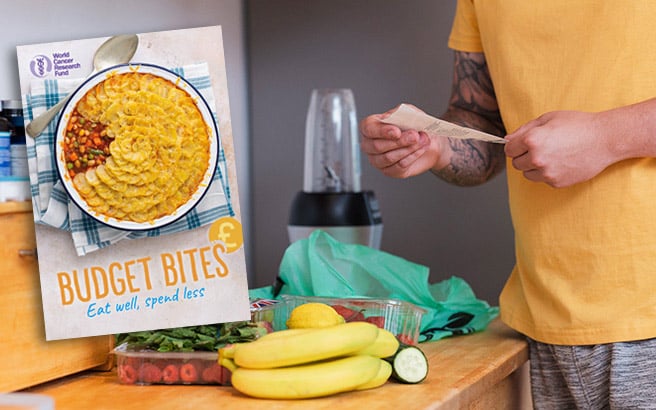We’re all seeing food prices rise as the cost-of-living crisis gets harder – and this can make it an even greater challenge for many of us to eat healthily, especially when our priorities may have changed.
But it’s more important than ever to look after our physical and mental health by eating well – it can help lift our mood, energise us and, importantly, reduce our risk of certain cancers.
When you’re pushed for time and money, processed or fast food may seem like the best option. While it’s often tasty, it also tends to be high in calories, fat, sugar and salt, while often low in vitamins, minerals and fibre.
And despite what you may have been led to believe, eating processed and fast food is rarely cheaper than eating healthy, home-cooked meals! Even though having a limited budget is one of the major barriers to eating a healthy diet, we want to show you that, with our tips and advice, you can still eat healthily on a budget.
Saving on your weekly shop
 Meal planning is a great way to help you stick to just buying what you need, and not be swayed by the various multi-buy deals on “junk food”. In fact, these deals lead us to buy more than we need. So even though they may seem like they save us money, they don’t!
Meal planning is a great way to help you stick to just buying what you need, and not be swayed by the various multi-buy deals on “junk food”. In fact, these deals lead us to buy more than we need. So even though they may seem like they save us money, they don’t!
Start by identifying foods you enjoy eating, then plan your meals around these. For some ideas, check out all our recipes or focus on the recipes we’ve created to be delicious and budget-friendly.
Cooking from scratch can be a great first step to eating better. Not only will you save money on takeaways, but it can be cheaper, fun (especially when you get the whole family involved) and build your confidence.
How about making your favourite takeaway food at home? Or why not try our healthier version of fish and chips or chicken and chips?
When you go shopping, theses ingredients are cheaper, filling and healthy, plus they’re versatile and can be used in many dishes. They also last for longer meaning less food waste – win-win!
- Wholegrain rice and pasta: brown or wild rice, and wholewheat pasta. Choose bigger packs if possible as the cost per portion will be less.
- Tinned pulses such as beans, chickpeas and lentils: choose ones without added salt or sugar. They’re a good source of plant protein and are often cheaper than animal protein. They also count towards your 5 A DAY.
- White or sweet potatoes.
- Tinned fruit and veg: choose fruit in natural juice rather than syrup, and vegetables in water without added salt.
- Frozen vegetables and fruit: these are just as nutritious as fresh and, yes, they still count towards your 5 A DAY! They’re also pre-prepared, which makes cooking quicker and easier. Using frozen vegetables and fruit can also help to reduce food waste.
- Frozen or tinned fish: if buying tinned tuna, look for varieties in spring water rather than brine.
- Chicken or turkey: these are better for us than red meat. Try buying bigger packs to lower the cost. Freeze what you don’t use.
- Herbs and spices: great for boosting the flavour of your dishes, fairly inexpensive and they last a relatively long time.
Eat well and save money
Here are some of our top tips to help you:
- Write a shopping list and check what food you already have at home before heading to the shops, to avoid buying things you don’t need.
- Look out for offers on bread that is near its best-before date – just pop it in the freezer when you get home. Aim for wholemeal where possible.
- Avoid shopping on an empty stomach as it may affect what and how much you buy. Being hungry can often lead to impulse buys.
- Be aware that special offers are not always the cheapest option.
- Buy in bulk if you can.
- Many own-brands are just as good as branded equivalents, but are often much cheaper. Typically, the more expensive branded products are at eye level. Look on the lower or higher shelves for cheaper products.
- If you have a larger supermarket nearby, they can often be cheaper to shop at than local convenience stores.
- If you make more than you need, put the leftovers in a container and freeze, or put in the fridge and use the next day. Or check out our recipes for using up leftovers.
- Buy in season. Seasonal fruits and vegetables tend to be cheaper.
- Some shops sell ‘wonky’ fruit and vegetables – there’s nothing wrong with them, they just vary in shape and size, but best of all they are cheaper.
- Check out your local market. They’re a great place to bag a bargain!
Where next?
For more cost-saving ideas and budget-friendly recipes, get a free copy of our latest cookbook, Budget bites.


 Even when you’re struggling with the cost of living, our tips – and free cookbook – can help you enjoy a nutritious meal for less. Our Health and Promotion Manager, Matt Lambert, explains how.
Even when you’re struggling with the cost of living, our tips – and free cookbook – can help you enjoy a nutritious meal for less. Our Health and Promotion Manager, Matt Lambert, explains how.